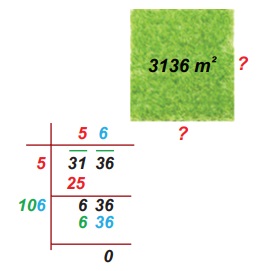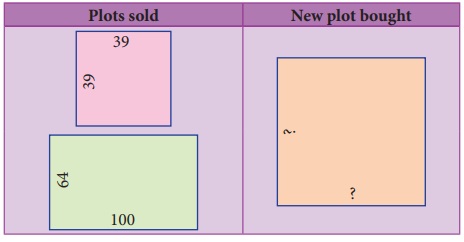Numbers | Chapter 1 | 8th Maths - Introduction to Square Numbers | 8th Maths : Chapter 1 : Numbers
Chapter: 8th Maths : Chapter 1 : Numbers
Introduction to Square Numbers
Introduction
to Square Numbers


More often
we write like this:
42=16
This says “4 squared is
16”
The 2 at
the top stands for squared and it indicates the
number of times the number 4 appears in the product (42 = 4 × 4 = 16).
The numbers
1, 4, 9, 16, ... are all square numbers (also called perfect square numbers).
Each of them
is made up of the product of same two factors.
A natural
number n is called a square number, if we can find another natural number
m such that n = m2.
Is 49 a square
number? Yes, because it can be written as 72. Is 50 a square number?
The following
table gives the squares of numbers up to 20.

Try to extend
the table up to 50 numbers!
We can now
easily verify the following properties of square numbers by referring the table
given above:
• The square
numbers end with 0, 1, 4, 5, 6 and 9 only.
• If a number
ends with 1 or 9, its square ends with 1.
• If a number
ends with 2 or 8, its square ends with 4.
• If a number
ends with 3 or 7, its square ends with 9.
• If a number
ends with 4 or 6, its square ends with 6.
• If a number
ends with 5 or 0, its square also ends with 5 or 0 respectively.
• Square
of an odd number is always odd and the square of an even number is always even.
• Numbers
that end with 2,3,7 and 8 are not perfect squares.
Think
1. Is the square of a prime number, prime?
Solution:
No, the square of a prime number ‘P’ has at least 3 divisors 1,
P and P2. But a prime number is a number which has only two
divisors, 1 and the number itself. So square of a prime number is not prime.
2. Will the sum of two perfect squares always be a perfect square?
What about their difference and their product?
Solution:
The sum of two perfect squares, need not be always a perfect
square. Also the difference of two perfect squares need not be always a perfect
square. But the product of two perfect square is a perfect square.
Try these
• Which among 256, 576, 960, 1025, 4096 are perfect square numbers?
(Hint: Try to extend the table of squares already seen).
Solution:
256 = 162
576 = 242
4096 = 642
∴ 256, 576 and 4096 are perfect squares
• One can judge just by look that each of the following numbers 82,
113, 1972, 2057, 8888, 24353 is not a perfect square. Explain why?
Solution:
Because the unit digit of a perfect square will be 0, 1, 4, 5,
6, 9. But the given numbers have unit digits 2, 3, 7, 8. So they are not
perfect squares.
1.
Some more special properties of square numbers
(i) The
square of a natural number other than 1, is either a multiple of 3 or exceeds a
multiple of 3 by 1.
(ii) The
square of a natural number, other than 1, is either a multiple of 4 or exceeds
a multiple of 4 by 1.
(iii) Th
e remainder of a perfect square when divided by 3, is either 0 or 1 but never
2.
(iv) Th
e remainder of a perfect square, when divided by 4, is either 0 or 1 but never
2 and 3.
(v) When
a perfect square number is divided by 8, the remainder is either 0 or 1 or 4,
but will never be equal to 2, 3, 5, 6 or 7.
Perfect numbers such as 6, 28, 496, 8128 etc., are not square
numbers.
Note
If a perfect square number ends in zero, then it must end with
even number of zeroes always. We can verify this for a few numbers in the table
given below.

Example 1.22
Th e
area of a square field is 3136 m2. Find its perimeter.
Solution:
Given
that the area of the square field = 3136 m2

∴The
side of square field = √3136 m= 56 m
∴The
perimeter of the square fi eld = 4 × side
= 4 × 56
= 224 m
Think
Consider the claim: “Between the squares of the consecutive
numbers n and (n+1), there are 2n non-square numbers”. Can it be true? How many non-square
numbers are there between 2500 and 2601? Verify the claim.
Solution:
If n = 50 ⇒ n2 = 502 = 2500
n + 1 = 51 ⇒ (n + 1)2 = 512 = 2601
Non−square numbers of 2500 and 2601 = 100 = 2 × 50 = 2 n
So it is true that between the classes of successive numbers n,
n + 1, there are non−square numbers of 2n.
Example 1.23
A real
estate owner had two plots, a square plot of side 39 m and a rectangular plot
of dimensions 100 m length and 64 m breadth. He sells both of these plots and
acquires a new square plot of the same area. What is the length of side of his
new plot?
Solution:
The transactions
can be visualised as follows:

Area of the
square plot bought = [ Area of the square plot sold ] + [ Area of the rectangular
plot sold ]
= [ 39×39
] + [ 100 × 64 ]
= [ 1521
] + [ 6400 ]
= 7921 m2

Length of
a side of the new square plot = √7921 = 89 m
Related Topics